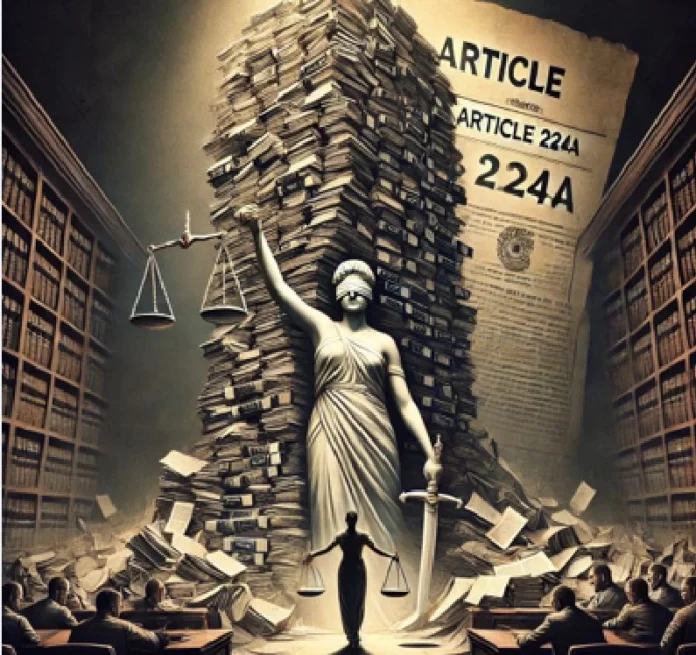By Justice Kamaljit Singh Garewal
Seventy five years after emerging as a sovereign republic, India faces an urgent crisis in its judicial system. The promise enshrined in the Preamble of the Constitution—to secure justice for all—remains largely unfulfilled due to an overburdened judiciary, long delays, and an alarming backlog of cases. The crisis is deepening, yet a constitutional solution exists: Article 224A, a long-dormant provision that allows for the appointment of ad hoc judges to tackle judicial pendency.
Despite a Supreme Court directive in Lok Prahari vs Union of India (2021) mandating the use of this provision, the government has failed to act. The judiciary continues to struggle under an avalanche of cases, while the Executive remains passive. The Supreme Court recently revisited the issue, relaxing conditions for appointing ad hoc judges, but will this finally spur action? Or are we heading towards an institutional stand-off between the Judiciary and the Executive?
A System in Gridlock
The Indian judiciary is staggering under the weight of more than 50 million pending cases across various courts. The time taken for judicial proceedings in any court of first instance is excessively long. First appeals, available as a right, add further years to litigation. High Courts, burdened with writ petitions, revision petitions, and public interest litigations (PILs), are struggling to function effectively.
While the Supreme Court and High Courts have repeatedly voiced concerns and suggested reforms, the situation has only worsened. The primary issue remains the shortage of judges. Without an adequate number of judges, no systemic reform—be it digitalization, alternative dispute resolution, or judicial infrastructure improvement—can significantly reduce pendency.
A Constitutional Solution Ignored
Article 224A of the Constitution provides a clear, pragmatic solution. Enacted in 1963, this provision allows for the appointment of retired judges as ad hoc judges in High Courts. These judges would have all the jurisdiction, powers, and privileges of regular judges. Their role would be to
assist the courts in clearing the backlog, ensuring that justice is delivered within a reasonable timeframe.
The Supreme Court, recognizing the gravity of the crisis, activated the dormant Article 224A in Lok Prahari and directed its immediate implementation. Yet, more than three years later, the government has not complied.
The ruling in Lok Prahari was based on extensive deliberations, including:
- Constituent Assembly debates, where the necessity of ad hoc judges was acknowledged.
- Past judicial precedents, such as Krishan Gopal (1974), Shankal Chand (1977), Venugopal (2003), Ashok Tanwar (2005), Anna Matthew (2009), and Indian Society of Lawyers (2011).
- Law Commission reports (79th, 124th, 188th and 249th), all of which recommended ad hoc judicial appointments.
- A Chief Justices Conference resolution (2016) supporting the activation of Article 224A.
Supreme Court’s Latest Directive
On January 31, 2025, a three-judge bench of the Supreme Court, comprising Chief Justice of India Sanjiv Khanna, and Justices BR Gavai and Surya Kant, revisited Lok Prahari and issued a fresh directive. The Court relaxed the conditions for appointing ad hoc judges, allowing each High Court to recommend two to five retired judges—up to 10 percent of the sanctioned strength—to tackle the backlog.
The Court had firmly stated in 2021: “We have taken the first step with the hope and aspiration that all concerned would cooperate… We must set aside apprehensions to chart this course, and we are confident that there will be a way forward.” The ruling had also mandated that the Ministry of Justice submit a progress report within four months. Now the time to act has arrived, action under Article 224A brooks no further delay.
Why Is The Government Hesitant?
Despite the Supreme Court’s clear directives, the government has remained reluctant to implement Article 224A. One possible reason is the first clause of Article 37, which states that Directive Principles are not enforceable by any court. However, Article 39A, inserted in 1976, explicitly mandates that the legal system must promote justice. The Judiciary has done its part—why is the Executive failing to act?
The Consequences of Inaction
Failure to implement Article 224A could lead to a constitutional crisis. With rising pendency and diminishing faith in the justice system, the situation is fast approaching a breaking point.
A delayed justice system undermines democracy itself. If citizens cannot secure their rights through timely legal remedies, constitutional governance itself is at risk.
As legal scholar Nani Palkhivala once observed: “The greatest drawback of the administration of justice in India today is delay. A law may be the finest piece of legislation, but if its implementation takes decades, it is meaningless.”
The Road Ahead
The Supreme Court had given the Executive a four-month window in 2021 to implement its directives. The ball is now in the government’s court. If action is not taken, we may be heading for an unprecedented clash between the Judiciary and the Executive.
Will the government uphold its constitutional duty and revive Article 224A? Or will it allow justice to remain an illusion for millions of citizens? The coming months will provide the answer.
—The writer is former judge, Punjab and Haryana High Court, Chandigarh and former judge, United Nations Appeals Tribunal, New York


